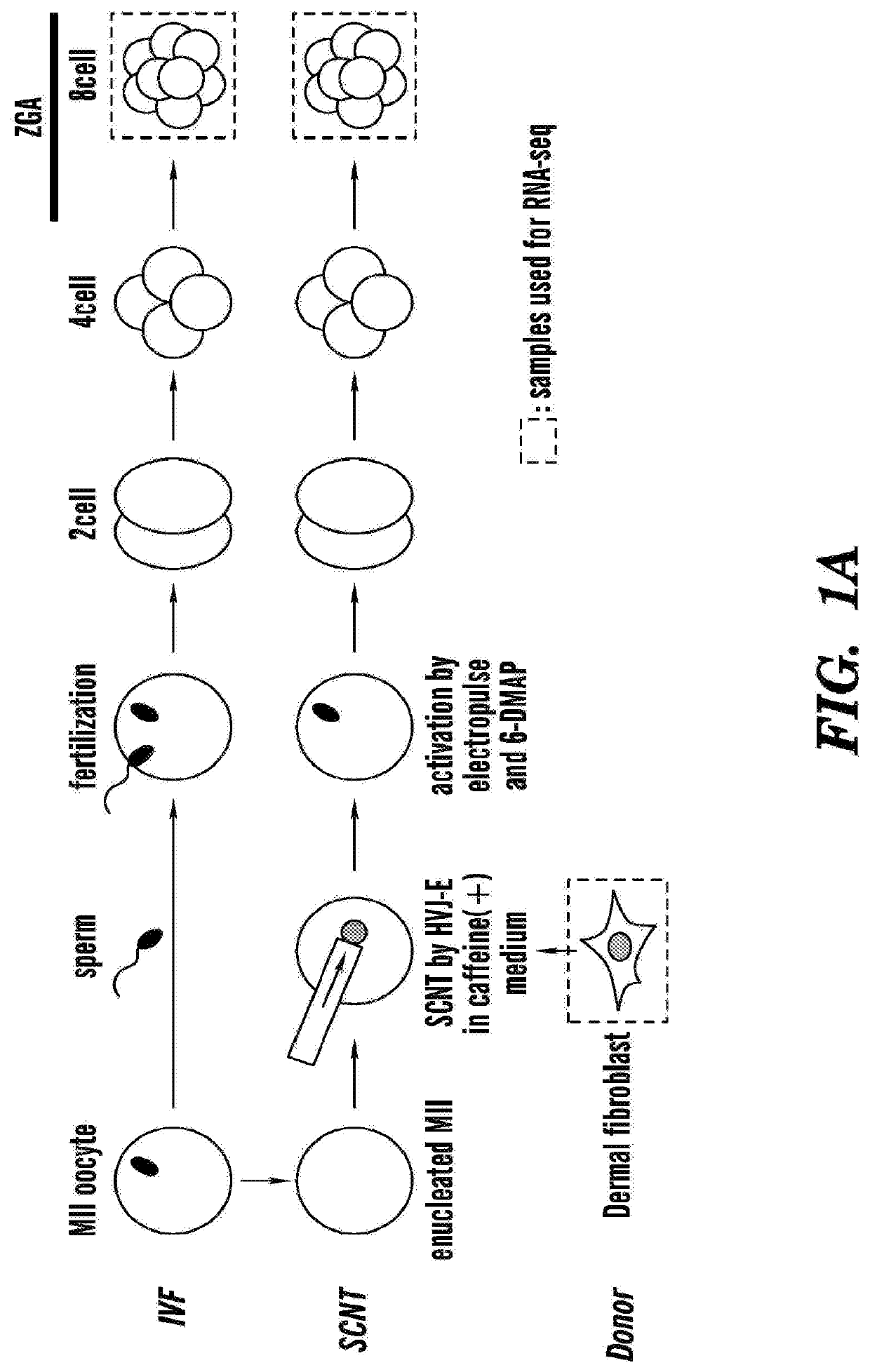Methods and compositions to increase human somatic cell nuclear transfer (SCNT) efficiency by removing histone h3-lysine trimethylation, and derivation of human nt-esc
a technology of somatic cell nuclear transfer and lysine trimethylation, which is applied in the direction of transferases, embryonic cells, enzymology, etc., can solve the problems of insufficient blastocyst quality and developmental efficiency, the failure of scnt embryos to develop into blastocyst or to term, and the inefficiency of mammalian scnt, etc., to achieve efficient production, improve human scnt embryo
- Summary
- Abstract
- Description
- Claims
- Application Information
AI Technical Summary
Benefits of technology
Problems solved by technology
Method used
Image
Examples
example 1
[0593]Identification of Reprogramming Resistant Regions in 8-Cell Human SCNT Embryos.
[0594]Unlike mouse zygotic genome activation (ZGA), which takes place at 2-cell stage, human zygotic genome activation (ZGA) takes place during the late 4-cell to the late 8-cell stages (Niakan et al., 2012) (FIG. 1A). To identify the genomic regions activated during ZGA of normal human IVF embryos, the inventors analyzed published human preimplantation embryo RNA-sequencing (RNA-seq) datasets (Xue et al, 2013) and identified 707 genomic regions ranging 20-160 kb in sizes (Table 5) that were activated at least 5-fold at the 8-cell stage compared to the 4-cell stage (Figure IB).
[0595]To determine whether ZGA takes place properly in human SCNT, the inventors collected late 8-cell stage embryos (5 / group), derived either from SCNT or IVF, and performed RNA-seq (FIG. 1A). In parallel, the inventors also performed RNA-seq of the donor dermal fibroblast cells (DFB-8, see method). Analysis of the 707 genomi...
example 2
[0600]Human KDM4A mRNA Injection Improves Development of Mouse SCNT Embryos
[0601]Having established that human RRRs are enriched for H3K9me3, the inventors next assessed whether removal of H3K9me3 could help overcome the reprogramming barrier in human SCNT embryos. The inventors previously demonstrated using mouse SCNT model that the H3K9me3 barrier could be removed by injecting mRNAs encoding the mouse H3K9me3 demethylase, KDM4d (Matoba et al., 2014). Before moving into human SCNT model, given that multiple members of the KDM4 family with H3K9me3 demethylase activity exist in mouse and human (Klose et al, 2006; Krishnan and Trievel, 2013; Whetstine et al., 2006), the inventors, instead of using KDM4D in facilitating SCNT reprogramming, assessed if other members of the KDM4 family, such as KDM4A could be used. In addition, the inventors also assessed if KDM4 family members could function across species.
[0602]To this end, the inventors performed SCNT using cumulus cells of adult fema...
example 3
[0606]Establishment and Characterization of Human ESCs Derived from KDM4A-Injected SCNT Blastocysts
[0607]The inventors next to derived nuclear transfer ESCs (NT-ESCs) from KDM4A-injected SCNT blastocysts. The inventors obtained a total of eight expanded blastocysts from KDM4A-injected SCNT embryos (FIG. 3 A and Table 4). After removal of the zona pellucida, the expanded blastocysts were cultured on irradiated mouse embryonic fibroblasts (MEF) in a conventional ESC derivation medium. Seven out of the eight blastocysts attached to the MEF feeder cells and initiated outgrowth. After five passages, the inventors successfully derived four stable NT-ESC lines, which were designated as NTK (NT assisted by KDM4A)-ESC #6-9, respectively (FIG. 3A, also named CHA-NT #6-9).
[0608]Immunostaining revealed that OCT4, NANOG, SOX2, SSEA-4 and TRA1-60 were all expressed with similar patterns to those of a control human ESC line derived by IVF (FIG. 3B, FIGS. 6A and 6B). RNA-seq (FIG. 6C) revealed that...
PUM
| Property | Measurement | Unit |
|---|---|---|
| Fraction | aaaaa | aaaaa |
| Volume | aaaaa | aaaaa |
| Volume | aaaaa | aaaaa |
Abstract
Description
Claims
Application Information
 Login to View More
Login to View More - R&D
- Intellectual Property
- Life Sciences
- Materials
- Tech Scout
- Unparalleled Data Quality
- Higher Quality Content
- 60% Fewer Hallucinations
Browse by: Latest US Patents, China's latest patents, Technical Efficacy Thesaurus, Application Domain, Technology Topic, Popular Technical Reports.
© 2025 PatSnap. All rights reserved.Legal|Privacy policy|Modern Slavery Act Transparency Statement|Sitemap|About US| Contact US: help@patsnap.com



